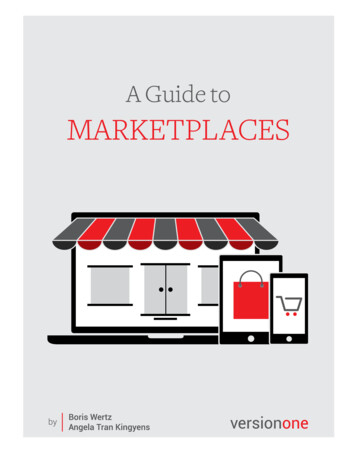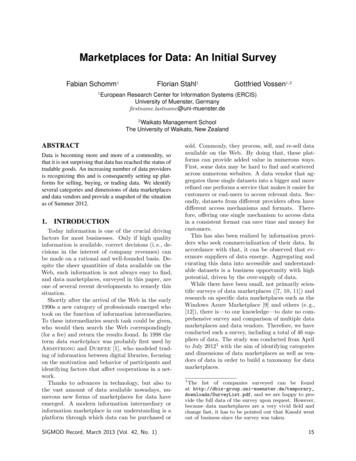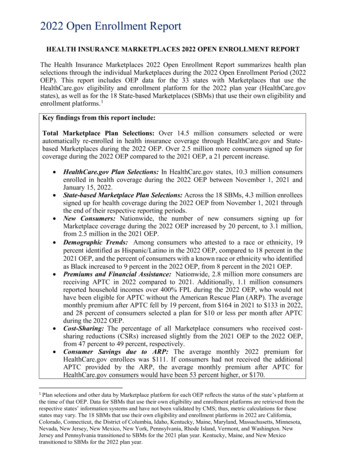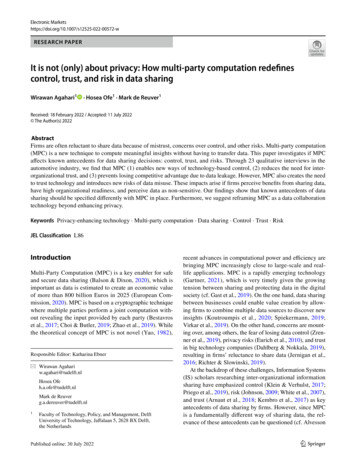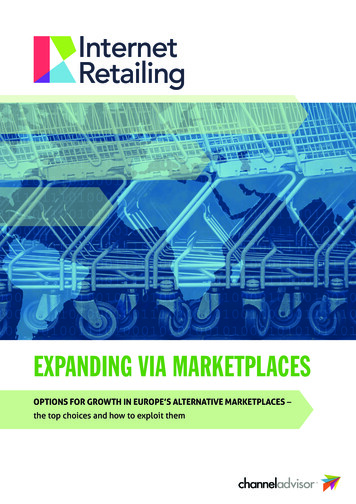
Transcription
EXPANDING VIA MARKETPLACESOPTIONS FOR GROWTH IN EUROPE’S ALTERNATIVE MARKETPLACES –the top choices and how to exploit them
02 l Expanding via MarketplacesExecutive SummaryMContents02 Executive summaryarketplaces have come to play a central role in e-commerce,for many smaller retailers being their main access to themarket. Even for larger retailers, marketplaces are starting tobe seen as a vital channel to run alongside their own websitesand other sales channels.They offer an excellent way for any retailer to expand their reach,attract new customers, trial new ranges and put a stake in the ground innew territories – often without having to make significant capital outlay.But marketplaces are maturing: and the marketplace environmentis seeing a new tier of services arriving that focus on niche areas, bothvertically and geographically. This second tier of marketplaces – oralternative marketplaces – offer retailers of any stripe new and interestingways to reach out to their core demographics, expand operations to newareas and to new territories, as well as offering them new ways to sell,often with interesting new business models.But what are these new marketplaces and how can you work them intoyour sales strategy? In this white paper we will take a look at a range ofthe key tier two marketplaces that have sprung up across Europe and theworld, discuss what they offer and outline expert advice as to how to workthem into your business.We start with a look at what more than 100 etail businesses are doingwith alterative marketplaces, what the main challenges are and how toovercome them. We will also outline what several key retailers are doingin the real world in our selection of case studies. So sit back and let’s diveinto the world of alternative marketplaces.03 Introduction04 The alternativemarketplaceopportunity06 Survey results08 Key alternativemarketplacessnapshot12 OperationalconsiderationsKEY SURVEY FINDINGS 52 and 56% of etailers are using Amazon and eBay respectivelyto sell – with more planning to do so as larger retailers look tomarketplaces as additional channels to market 52% of retailers see that expanding marketplace trading to newmarketplaces has a strategic advantage for them 32% remain unsure as to how to do this Lack of time and lack of ROI understanding are putting 32 and15% off respectively Knowledge of the existence of many mainstream tier twomarketplaces is very low14 Case studies18 Practice of the best20 SummaryABOUT THE AUTHORPaul Skeldon is editor of M-Retailing and eSeller.net
Expanding via Marketplaces l 03The key to growing on marketplacesWhat is the key to growing on marketplaces?This white paper should help deliversuccess and enable you to fully leveragethe opportunities that await. I hope youenjoy reading it and are able to act on itsrecommendations.Marketplaces have exploded in popularity internationally,with giants eBay and Amazon at the heart of many retailers’e-commerce strategies. But at a time where new andemerging marketplaces are starting to change the onlineretail game, it makes sense to look at alternatives outsideof these two giants to be able to create a marketplacesframework – and fully exploit these new choices.This report will delve into the top new marketplaces inEurope retailers should look into – based on our experienceand the current trends in the industry.At ChannelAdvisor, we focus on unlocking retailers’ fullselling potential on any marketplace. We provide them witheverything they need to connect to customers and boostsales on more than 90 marketplaces (and counting) aroundthe globe. All year, we keep pace with the latest trends andchanges in the marketplaces – it is essential for us to bemonths ahead of retailers in a fast-evolving industry wherenothing can be taken for granted.Bringing in a third party such as ChannelAdvisor togrow your presence on marketplaces is the first step toe-commerce success. Our comprehensive platform issteps ahead and seamlessly lists, manages and optimisesproducts. One of the areas online sellers struggle withis inventory: we keep inventory in sync, and productorganised, using in-depth analytics to sell more intelligentlyon various marketplaces.With so much choice in the marketplaces web, it is onlynatural merchants need a little push. How can we help themsell more? Using a third-party like our ChannelAdvisorMarketplaces platform helps optimise product data tomeet marketplaces listings requirements (and avoidsuspensions), manage inventory across all channels (andavoid overselling) and of course win the Buy Box and BestOffer positions on the big marketplaces – all thanks to ouralgorithmic repricing.In this fast-paced industry it is our mission to usemachine learning and real time analytics to analyse andautomatically adjust pricing when necessary, based on themerchant’s desired SKU-level maximums and minimums.We help our customers grow on Amazon and eBaymanaging fulfilment programmes and achieve big resultson first-party (1P) selling - but we are supporting new andemerging European marketplaces too.Considering the new third-party marketplaces can be avaluable avenue for growth as they can offer considerableextra exposure for your products. To only name a few,marketplaces cropping up all the time are Tophatter, themajor mobile shopping platform, SKU Cloud with Flubit,the largest UK owned marketplace, and Fruugo, thenewcomer selling into 32 countries abroad.Other specialty marketplaces such as ManoMano (a newdistribution channel for DIY related products), Zalando(over 1500 brands of fashion items) and Game (the platformfor anything gaming or tech focused) are strong contestantsin Europe.We hope this report will give you some food for thoughtwhen it comes to choosing where to sell and which thirdparty partners can help manage your presence and growthon marketplaces.Hakan ThyrDirector, Strategic Partnerships, EMEA
04 l Expanding via MarketplacesThe alternative marketplace opportunityMarketplaces have grown in popularity among consumers because theyoffer choice, convenience and, with mainstream channels such asAmazon and eBay, price competitiveness.For merchants they offer a ready-made shop window, often openall over the world, and a centralised place that can handle all the hardwork of SEO, marketing, logistics and even warehousing.But while these things have all become vital to e-commerce on both themerchant and consumer sides, they don’t tick all the boxes.Price isn’t necessarily the only consideration shoppers have when buyingand, while the likes of Amazon and eBay do offer a vast choice, many shoppersare increasingly looking for the specialist or unusual goods that go to make theworld a more interesting place.For this reason, smaller, more specialised marketplaces have evolved thatservice niche markets, offer more unusual products, or which have developednew business models and offer a wholly different experience to the user.THE MARKETPLACE OPPORTUNITYOne of the key reasons that merchants of all sizes are using marketplaces isthat they offer a simple way to connect with customers. While they can, to somedegree, take the headache out of SEO and marketing, what they offer many isthe ability to act as a test bed of vanguard into new markets.For any retailer, expanding geographically or expanding inventory is a gamble.From a geographical point of view, there is much to consider: language, currency,customs, red tape and more. Expanding cross border can be a nightmare.Marketplaces that operate in the countries that you wish to service can be aneasy first step to test the waters.The same applies to expanding the range of goods sold, with marketplacesgiving merchants the ability to test out their theoretical idea that there may be abigger market out there for related goods without having to over commit.Where alternative and second tier marketplaces come into their own is thatthey often have both geographical and specialisation of goods covered.The UK is an unusual market for marketplaces. Here there are relatively fewsecond tier marketplaces since pure-play e-commerce has become so successful,but some newcomers are trying to shake up the marketplace game. Mainstreamretailers dominate their sectors with their own transactional websites and theslack out side of this is filled by Amazon and eBay.Overseas, however, things are very different. In France the secondarymarketplace market booms. Similarly in China. These offer retailers andmerchants in the UK the chance to enter overseas markets on specialised sitesthat will generate significant uplift in sales.As we shall see in the Case Studies section of this report (see p14), manyretailers are seeing a 5% uplift in using these specialised marketplaces inoverseas markets as they rapidly and cheaply get their goods in front ofshoppers in those lands.SPECIALISATIONThe other reason to consider tier two marketplaces is that they are often muchmore specialised and dedicated to a particular niche. This means that as amerchant, you may well find that your niche products find a smaller, but moresignificant, audience on non-mainstream website.Take for example rock climbing. This is a dangerous, high-adrenaline sportand requires some pretty specialised equipment. It is also, since it isn’t for thefeint hearted, quite a niche pastime. As a result, any dedicated rock climber
Expanding via Marketplaces l 05“From amerchant’s point ofview, putting goodsout on specialisedmarketplacesputs you in frontof the reallydiscerning shopper– and discerningshoppers are notdriven so muchby price, but byuniqueness, qualityand suitability”isn’t going to go looking on Amazon for the cheapest gloves, boots, cramponsand ropes – no one wants to be dangling off a sheer rock face marvelling at howcheap their equipment is.This is ideal territory for using a specialist, tier two marketplace: it has theaudience and you have the products.But it doesn’t have to be extremely niche offerings that can benefit fromthis approach. The reason for this growing interest in alternative and morespecialised marketplaces is that shoppers are starting to look for them.Take cycling as another example. Companies such as Evans cycles orWiggle are essentially alternative marketplaces for bikes and bike relatedparaphernalia. They sell a range of brands and all the accoutrements that gowith it – clothing, helmets, cleats and more. If you want to buy a bike, they youare probably going to end up on a bike site like this, rather than Amazon if yougo through Google because they are specialists in a mainstream offering.The model works across any sector pretty much that you can think of. Evenfashion apparel has its own niche marketplaces, such as Zalando, which tradeson offering things that lie outside the mainstream. This approach is increasinglywhere a section of the consumer market is looking for goods: outside themainstream.From a merchant’s point of view, putting goods out on specialisedmarketplaces puts you in front of the really discerning shopper and to someextent gets you away from the race to the bottom in terms of price. Discerningshoppers are not driven so much by price, but by uniqueness, quality andsuitability. By being on a dedicated site that specialises in the kind of thing yousell is a stamp of approval and a way to protect margins.NEW BUSINESS MODELSOutside of the obvious expansion and specialisation vectors that thesealternative marketplaces offer, there are a crop that are also laying down newbusiness models on the somewhat tired marketplace formula, aiming to attractshoppers and merchants through being novel, more entertaining and, in onecase, addictive (but in a fun way!).To use the example of Zalando again, this fashion retailer, while focusingon offering not-on-the-high-street fashion collections, also offers freeshipping and free 90-day returns, with rapid dispatch to anywhere in theworld as part of its modus operandi. The logic behind this is that it takesone of the main pain points out of buying clothes online: the fact that it maynot fit/suit/be appropriate. It also subconsciously offsets the fact that thedesigner gear it sells is not cheap, although as said before, users of this siteare not really driven by price.From a merchant point of view this also makes using the Zalando marketplacemuch more attractive. Not only are you reaching the kind of audience youwant to reach – and not having to compromise on price to do so – but themarketplace is making your goods available across the globe and handles thelogistics for you.Taking the idea of new business models as a way to make a marketplace standout, Tophatter seems to have hit on a winner with its approach which sees itoffering goods on rapid 90 second auctions. Predominantly aimed at the mobilegeneration, Tophatter can be costly for sellers – taking some 25% on some itemsin commission – but it does guarantee front page profile of everything and isshifting thousands of items a week.The beauty lies in the addictive nature of the service. With users able to get asmuch as 80% off goods in these rapid auctions, it sees users come back over andover again and, with anything that looks too good to be true, sees them spend more.These two examples show that, as a merchant, you can get significant upliftin your sales by adding alternative marketplaces to your portfolio of saleschannels.
06 l Expanding via MarketplacesSurvey resultsThe role of the alternative marketplace ine-commerce is in its infancy, but already theyoffer clear advantages to sellers. In the yearsahead, they will also, we believe, to changethe face of e-commerce just as mainstreamDO YOU SELL ONAMAZON AND EBAY?To set the scene, itcomes as no surprisethat the majority ofthose surveyed do useAmazon and eBay orare planning to do sothis year. 52% are onAmazon and 56% oneBay. To the untrainedeye this may seemlower than expected,but many mainstreamretailers are only nowconsidering addingmarketplace sellingto their multichannelstrategy, which isreflected in theseresults.IS EXTENDING YOURMARKETPLACE STRATEGYOF COMPETITIVEADVANTAGE?The bulk of respondentsdo see extending theirmarketplace presence asa key strategic move, butmany are still unsure.52% are positive that itwill help, but 32% fall into the don’t know camp.Why is revealed in thenext chart.marketplaces have in past decade.But what do retailers think about them right now? Forthis white paper we surveyed more than 100 UK etailersfrom across the board to assess their views. Here is whatthey told us.
Expanding via Marketplaces l 07WHAT STOPS YOUR USINGOTHER MARKETPLACES?As we can see from this graph,lack of time and staff and lackof ROI are major contributorsto why nearly have ofrespondents either are unsureor aren’t going to extendtheir marketplace strategy.Interestingly, a third of themcite ‘other’ pointing to lessdefined reasons. One of whichis lack of understanding –something we hope this whitepaper can help deal with.WHAT ARE YOUR PLANS FORALTERNATIVE MARKETPLACES?So which alternativemarketplaces are in the lineof fire? The research hereagain points to a distinctlack of awareness of what isavailable and what it can do– again pointing to why thiswhite paper is so important.Across the board the six mainalternative marketplaces outthere score highly on “neverheard of”, with only singlepercentage points of usersplanning to use them. OnlyGAME and Zalando scorehigher “heard of” scores then“not heard of”. GAME is wellestablished as a brand, havingbeen on the High Street foryears before becoming anonline pure play, and Zalandohas engaged in a prominentmedia campaign in recentmonths.
08 l Expanding via MarketplacesKey alternative marketplaces“There aremany alternativemarketplacesspread across theglobe and, with thelikes of mainstreamretailers openingup a section oftheir own websiteto essentially act asa marketplace forrelated third partysellers, it is quite abroad church”As we have seen, the majority of etail businesses we surveyed are usingAmazon and eBay for marketplace trading. The fact that these twobehemoths don’t score at near 100% is because many mainstreamretailers are only now starting to look at working marketplaces of anysize into their omni-channel strategy.But what is more noticeable from the research is that the majority of retailerswe surveyed have not heard of many of the key alternative marketplaces that areavailable to them for niche selling or for overseas expansion.There are, or course, many, many alternative marketplaces spread across theglobe and, with the likes of mainstream retailers such as Halfords opening up asection of their own website to essentially act as a marketplace for related thirdparty sellers, it is quite a broad church.But based on traffic and popularity we have pulled out the six that we think arethe ones to watch and which offer a broad spectrum of vertical and geographicalmarket coverage.FRUUGOFruugo’s claim to fame is that it simplifies buying products from around theworld – offering secure and safe shopping from anywhere in the world throughone global marketplace.From e-commerce merchant’s perspective, Fruugo simplifies selling aroundthe world and can not only help retailers sell into overseas territories, but canalso help win Google shopping visibility in those countries – probably a lot moreeasily than trying to do so through multiple localised websites.Retailers can list their products for sale on Fruugo and Fruugo’s proprietarybasket takes the shopper’s order. The platform is multi-country, multi-language,multi-currency, multi-shipping and multi VAT compatible. The retailer processesthe Fruugo order, dispatching it to the shopper, and Fruugo simply charges asmall commission on the sale.Fruugo automatically “localises” all products (currency, language, VAT)for shoppers in countries around the world and (the big benefit for retailers)automatically gains visibility and sales for retailers via country-specific andlanguage-specific versions of “Google Shopping” elsewhere in the world. There’sno CPC (cost per click) cost to the retailer.The marketplace takes any fraud risk and currency risk as well as offering firstline Customer Services thus reducing managerial workload. The merchant canalso select which Fruugo supported countries to sell to.Key Fruugo StatsTop Cross border order destinations 76% of Fruugo orders are cross-border and 73% are crosscurrency (not every international order is cross-currency, e.g.cross border within Eurozone) Western Europe 41% Fruugo is on target to exceed 10m annual GMV this year, from1.3m products, and 1m visits per month. All retailers benefit free of charge from Fruugo’s automatedprogramatic buying of traffic from Google Shopping globally & majorComparison Shopping Engines (such as myshopping.com.au). Australia 21% Scandinavia 18% North America 16% Rest of World 4%Key markets Sports and Outdoor Health and Beauty Home and Garden
Expanding via Marketplaces l 09Key tophatter Stats Tophatter tends of focus on SKUs that sell inthe 10 to 25 range There is an 80% sell through rate and it sellsmore than 2 million items per month Pay zero fees for first 30 days (after that, payonly when your items sell) Tophatter covers any ‘losses’ incurred throughstarting your auctions at 1. They take the riskfor you. Many Tophatter sellers generate 1 million – 10 million per year Tophatter boost your account performance tohelp you scale fasterKey markets Jewellery Electronics Beauty FashionTOPHATTERTophatter is an interesting marketplace as it takes a wholly different approachto pretty much all others. On Tophatter, shoppers compete in fleeting90-second auctions to win deals of up to 80% off jewellery, electronics, beauty,and fashion – on mobile.And it works: every week thousands of marketplace sellers sell more than500,000 products to a community of 10 million shoppers in the US, UK,Europe, Canada, Australia, New Zealand, and elsewhere.Tophatter is now a major mobile shopping platform alongside Amazon,eBay, Sears, Walmart and other leading marketplaces. If you’re a professionalonline seller, there are several reasons to sell on Tophatter.Every item is featured on the front of the mobile app and website – largelybecause inventory moves really quickly with an 80% sell through rate. In anage when eBay and other platforms are moving away from auctions, Tophatterre-invented the auction to be faster and mobile optimised for the modern-dayshopper.Interestingly, Tophatter charges no no ongoing monthly fees or listing fees,instead taking commission. In some instances this can be as high as 25%plus a 0.50 fee for clothing for each item that is sold, but according to thecompany this is to cover the higher costs of driving marketing on Facebook,Google, TV, and other channels. What you’re paying for is a lot of eyeballs onyour products, the company says.MANOMANOKey ManoMano Stats After setting out to disrupt the UK DIY scene– predominantly occupied by B&Q andHomebase – ManoMano generated sales of 4.4 million in the year to April. It has secured partnerships with 100 localmerchants and has listed 185,000 productsduring the period.Key markets DIY goods Tools Garden tools Gardening goods Garden furnitureManoMano is a DIY and garden/outdoors goods marketplace that focuses ongetting the best deals on DIY and garden products and maintaining a greatrelationship between its merchants and its customers.It is dedicated to finding the best value DIY/decoration/garden specialiststhen negotiating with them to achieve exclusive preferential tariffs forManoMano users who shop the site.It also looks to select the sellers allowed on ManoMano using strictreliability criteria and make its catalogue accessible on one single internet sitewith stocks updated in real-time;It also claims to guarantee that what the shopper gets is what the shopperordered and expects.It works by letting the customer choose and order online from ManoMano.co.uk their favourite products out of a choice of more than 80,000 productsavailable in our catalogue. ManoMano sends the customer order to the sellerand blocks their payment in a secure third party account.The seller dispatches the order. The customer receives their order andchecks the contents.The website also features a blog as ManoMano attempts to build aninterconnected community and offer more than just DIY and gardenequipment. Thanks to this growing community of DIY enthusiasts, ManoManoaccompanies DIY-ers from a project’s beginning to end, as well as installationwith the help of SuperMano, a service connecting handymen and peopleseeking assistance with home improvement.
010 l Expanding via MarketplacesKey GAME Stats With more than and 18m Reward CardMembers, GAME is the UK’s leadingvideo game retailer. 1.7m unique visitors per week 10m individual page views each week 87% trust in brandKey markets Mobile phones Laptops Computers Gadgets New technology Clothing Figurines DVDs & Blu-Rays Technology/gaming related accessoriesAnd of course: Video Games Consoles Anything gaming, gadget or technology relatedGAMEInitially a multi-channel retailer with a website and 300 High Streetshops, GAME has since rebranded and re-emerged as a website selling‘computer games’ and attendant paraphernalia. In recent times it hasrebranded itself as a games focussed marketplace.This popularity sees its website log more than 1.7 million uniquevisitors each week. These visitors purchase anything and everythingto do with technology, gadgets and video games. The newly developedGAME Marketplace gives third party sellers the unique opportunityshare this success by integrating their products on GAME.co.uk.The advantage of the GAME marketplace is that, unlike othermarketplaces, with GAME there are zero set-up fees, zero subscriptionfees and zero listing costs. You only pay commission on sales that youmake. Listings will be seamlessly integrated on the same webpages asGAME’s giving you access to a massive online audience. The website hasmore than 10 million individual page views each week.When polled 87% of people said the GAME brand provided them withreassurance. With GAME Marketplace third party sellers can harnessGAME’s reputation among its loyal customers.GAME says it is committed to helping sellers with promotions, socialmedia, newsletters and other marketing activity. Once a seller’s initialinformation has been received, a member of the GAME Marketplaceteam will set-up a phone call to get them properly on board. Set up iseven easier if you currently use marketplace aggregators Linnworks orChannelAdvisor.AZOYAAzoya offers a unique take on the marketplace model, providing whatis to all intents and purposes a marketplace for retailers to reach theenormous Chinese market, but to the Chinese consumers remains totallyinvisible.Although Azoya helps you with all the operational work in China, itremains invisible to Chinese customers. Instead, Chinese customersonly know they are buying directly from you, experiencing your productsand services, approving of your brand. You are given the privilege tobuild your own customer base and customer loyalty, rather than beingrestricted by the local E-com platforms.Under Azoya’s one-stop solutions, you won’t risk your investment onsetting up local business entity, hiring local staff or opening office inChina, etc. There’s no entry cost, which is indispensable in traditionalexpansion. No local stocking is needed, which will significantly reducethe risks you face. Since Azoya’s solutions and services cover all aspectsin cross-border e-commerce, you don’t need to find other local partners.With its all-encompassing services and dedicated specialist team,the company has won trust from more than 35 overseas retailers in 11countries, such as La Redoute, the largest online retailer of women’sapparel in France; and Feelunique, the largest online premium beautyretailer in Europe.Key Azoya StatsKey markets35 retailers in 11 countriesAll verticals in the Chinese market
Expanding via Marketplaces l 011ZALANDOKey Zalando Stats 560m unique visitors in Q4 2016 more than 60 well-known brandssell on Zalando in the UK, includingTopShop, Whistles, Hunter, BoxFreshand AddidasKey marketsFashion apparel and shoes across Germany,Austria, Switzerland, France, Belgium, theNetherlands, Italy, Spain, Poland, Sweden,Denmark, Finland, Norway and the UnitedKingdom.Zalando is a Berlin-based marketplace that specialises in fashion –clothes and shoes – and differentiates itself from other fashion retailersby offering extremely generous shipping and returns policy. Both arefree.The option to pay after receiving the items, as well as the 90 daysreturn policy are highly attractive options for internet shoppers and exertan even stronger influence on first-time online buyers who hold back onpurchasing online often because of perceived risk.In 2011 Zalando launched Zalando.co.uk, thereby offering its retailservices to UK customers. Deliveries were operated by YODEL. Inthe same year Zalando launched a TV ad in English, replicating thehumorous format used in its German-language commercials. In it, along-suffering husband bemoans his wife’s addiction to buying shoes andwarns other men about the dangers of introducing women to Zalando.In 2015, Zalando acquired a 20% stake in Cheltenham-based softwarecompany Anatwine, headed by a former e-commerce director ofSuperGroup, for a seven-figure sum. Anatwine’s software — which helpsonline fashion retailers and brands integrate their processes, systemsand stock files — will enable current and future clothing and accessorybrand clients to use Anatwine’s technology to sell their merchandisethrough Zalando. Zalando is expected to speedily widen Anatwine’srange of brands.The company operates in the following European countries: Germany,Austria, Switzerland, France, Belgium, the Netherlands, Italy, Spain,Poland, Sweden, Denmark, Finland, Norway and the United Kingdom.OTHER INTERESTING MARKETPLACESOther alternative marketplaces you maywish to consider include:ALLEGRODAWANDAAs Europe’s fifth most-visited onlinemarketplace, Allegro is the onemarketplace to consider if you’re tryingto reach customers in Eastern Europe.Located in Poland, Allegro has over 12million registered users and a massivehold over many of the key e-commercesectors in Poland.Branded as the online marketplacefor “Products with Love”, DaWanda isan online marketplace for merchantsselling unique and handmade products,not dissimilar to Etsy. Merchantslooking to sell niche, distinctiveproducts should consider DaWanda,which encourages the sale of items thatare responsibly sourced.CDISCOUNTCdiscount is the second-largeste-commerce website in France (afterAmazon) with 16 million registeredbuyers and over 1 billion of sales.Registration requirements are sellerfriendly although sellers must have acompany registration number, productdata and the ability to offer customerservice in French.PRICEMINISTERPriceMinister is the second most-visitede-commerce site in France. It hasmore than 9 million unique visitors amonth and is home to a wide variety ofproducts, including books, video games,clothing, home and food.
012 l Expanding via MarketplacesOperational considerations ofadditional marketplacesThe business case for additional marketplaces is clear, but as oursurvey showed understanding of them is not as high as it should be.One of the many reservations merchants have expressed is that theyare unsure of how to choose the marketplaces that work for them,how to integrate them into their existing portfolio and how to assessROI. So how do you do it?CHOOSING A MARKETPLACEThe first port of call is which marketplaces to use. The first thing to do whenassessing alternative marketplaces – or any marketplaces for that matter – is tolook at past performance. Take a look at which niches each serves, does it hit yoursweet spot and what sort of traffic is it doing?But marketplaces, as we have se
At ChannelAdvisor, we focus on unlocking retailers' full selling potential on any marketplace. We provide them with everything they need to connect to customers and boost sales on more than 90 marketplaces (and counting) around the globe. All year, we keep pace with the latest trends and changes in the marketplaces - it is essential for us .


